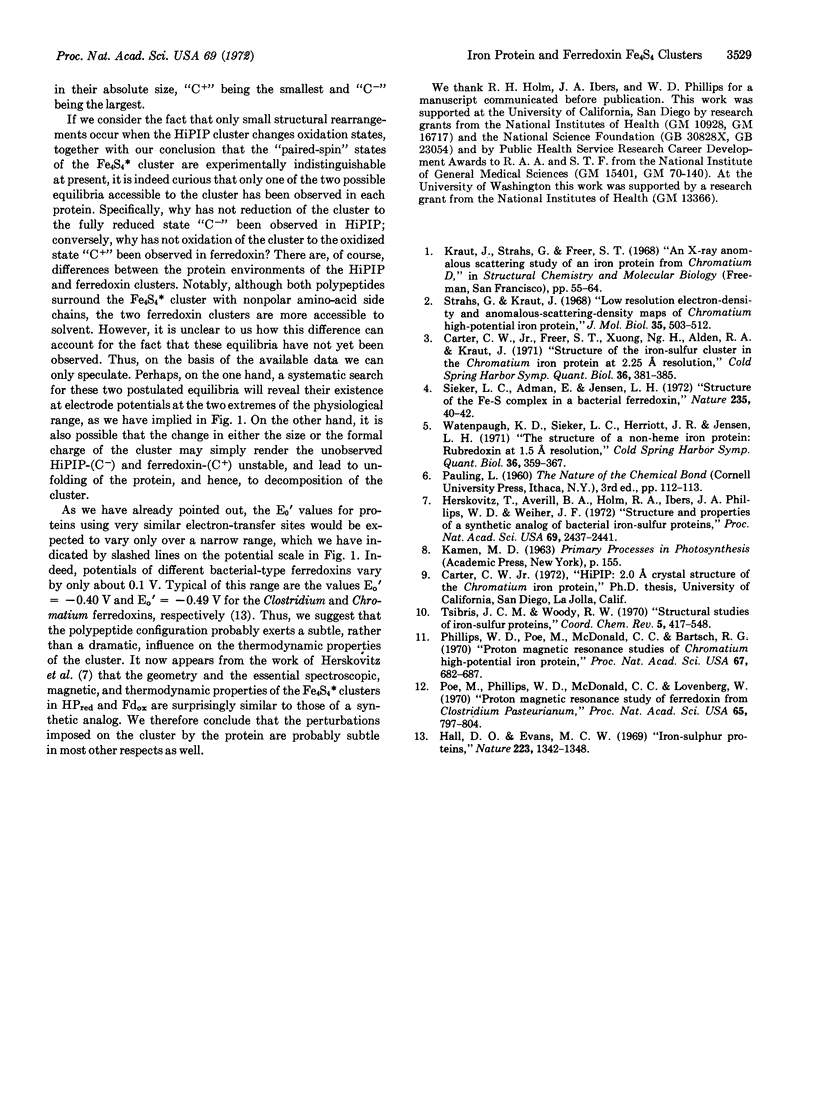Abstract
The structures of both oxidized (HPox) and reduced (HPred) high-potential iron protein and of oxidized ferredoxin (Fdox) have been partially refined at 2.0-Å resolution by methods similar to those applied to the protein rubredoxin [Watenpaugh, K. D., Sieker, L. C., Herriott, J. R. & Jensen, L. H. (1971) Cold Spring Harbor Symp. Quant. Biol. 36, 359-367]. Average bond lengths and angles in the HPred and Fdox Fe4S4* clusters are the same to within the root-mean square (rms) deviation of each mean value. A preliminary comparison of the two HiPIP oxidation states indicates that the HPox cluster is geometrically similar to the HPred cluster, but that it is smaller by 0.1-0.2 Å in certain dimensions. The HiPIP and ferredoxin cluster geometry is also nearly identical to that reported recently for a synthetic analog [Herskovitz, T., Averill, B. A., Holm, R. A., Ibers, J. A., Phillips, W. D. & Weither, J. F. (1972) Proc. Nat. Acad. Sci. USA 69, 2437-2441]. An apparent paradox presented by the large difference between the HiPIP and ferredoxin electrode potentials can be resolved by the assumption that the Fe4S4* cluster has not two but three oxidation states. The fully oxidized (HPox) and fully reduced (Fdred) clusters are paramagnetic, and the intermediate state is spin-paired [Tsibris, J. C. M. and Woody, R. W. (1970) Coord. Chem. Rev. 5, 417-458]. This hypothesis is supported by structural and spectroscopic evidence that the “paired-spin” state exists in both HPred and Fdox.
Keywords: protein structure refinement, electrode potentials
Full text
PDF



Selected References
These references are in PubMed. This may not be the complete list of references from this article.
- Carter C. W., Jr, Freer S. T., Xuong N. H., Alden R. A., Kraut J. Structure of the iron-sulfur cluster in the Chromatius iron protein at 2.25 Angstrom resolution. Cold Spring Harb Symp Quant Biol. 1972;36:381–385. doi: 10.1101/sqb.1972.036.01.049. [DOI] [PubMed] [Google Scholar]
- Hall D. O., Evans M. C. Iron-sulphur proteins. Nature. 1969 Sep 27;223(5213):1342–1348. doi: 10.1038/2231342a0. [DOI] [PubMed] [Google Scholar]
- Herskovitz T., Averill B. A., Holm R. H., Ibers J. A., Phillips W. D., Weiher J. F. Structure and properties of a synthetic analogue of bacterial iron--sulfur proteins. Proc Natl Acad Sci U S A. 1972 Sep;69(9):2437–2441. doi: 10.1073/pnas.69.9.2437. [DOI] [PMC free article] [PubMed] [Google Scholar]
- Phillips W. D., Poe M., McDonald C. C., Bartsch R. G. Proton magnetic resonance studies of Chromatium high-potential iron protein. Proc Natl Acad Sci U S A. 1970 Oct;67(2):682–687. doi: 10.1073/pnas.67.2.682. [DOI] [PMC free article] [PubMed] [Google Scholar]
- Poe M., Phillips W. D., McDonald C. C., Lovenberg W. Proton magnetic resonance study of ferredoxin from Clostridium pasteurianum. Proc Natl Acad Sci U S A. 1970 Apr;65(4):797–804. doi: 10.1073/pnas.65.4.797. [DOI] [PMC free article] [PubMed] [Google Scholar]
- Sieker L. C., Adman E., Jensen L. H. Structure of the Fe-S complex in a bacterial ferredoxin. Nature. 1972 Jan 7;235(5332):40–42. doi: 10.1038/235040a0. [DOI] [PubMed] [Google Scholar]
- Strahs G., Kraut J. Low-resolution electron-density and anomalous-scattering-density maps of Chromatium high-potential iron protein. J Mol Biol. 1968 Aug 14;35(3):503–512. doi: 10.1016/s0022-2836(68)80010-5. [DOI] [PubMed] [Google Scholar]
- Watenpaugh K. D., Sieker L. C., Herriott J. R., Jensen L. H. The structure of a non-heme iron protein: rubredoxin at 1.5 Angstrom resolution. Cold Spring Harb Symp Quant Biol. 1972;36:359–367. doi: 10.1101/sqb.1972.036.01.047. [DOI] [PubMed] [Google Scholar]


